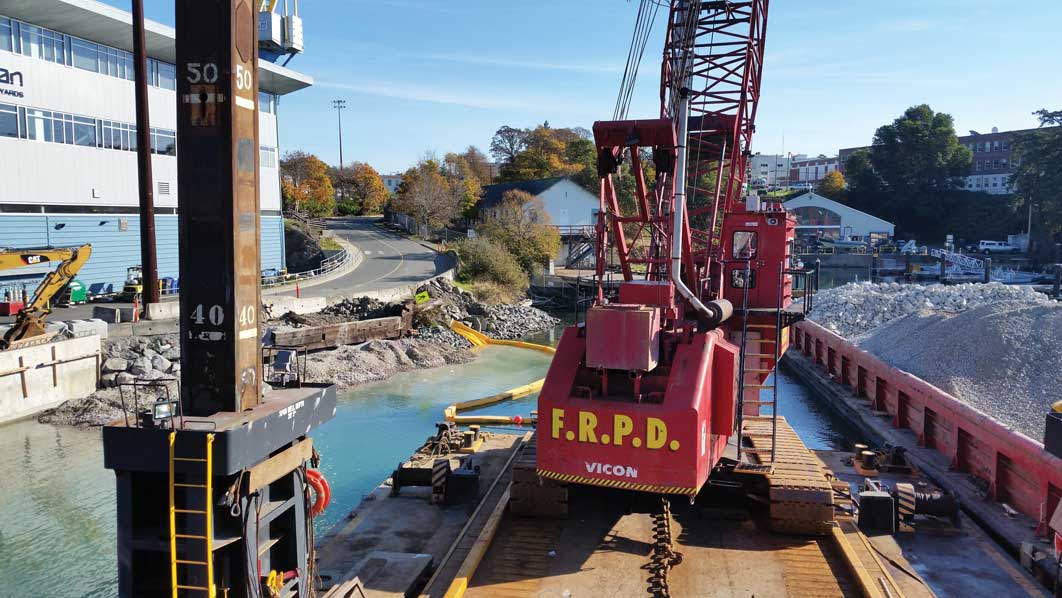
Vancouver Island’s Esquimalt Harbour, west of downtown Victoria, B.C., is home to the Canadian Forces Base Esquimalt and the Esquimalt Graving Dock, the largest dry dock and ship repair facility on Canada’s West Coast.
The graving dock facility includes several massive jetty structures, which are used as staging and additional tie-up areas for the dry dock. They are also where the vast majority of fitting-out, maintenance and repair work are done on vessels when they don’t have to be in the dry dock.
Originally built in 1927, on relatively short timber piles, the South Jetty was deteriorating and assessed as likely to collapse in the event of a large earthquake. Once the Government of Canada determined that the jetty had to be replaced, Public Works and Government Services Canada selected the Tsleil-Waututh Nation’s project management company, SPAL General Contractors Corporation, in partnership with Fraser River Pile and Dredge (GP) Inc. (FRPD), to reconstruct it.
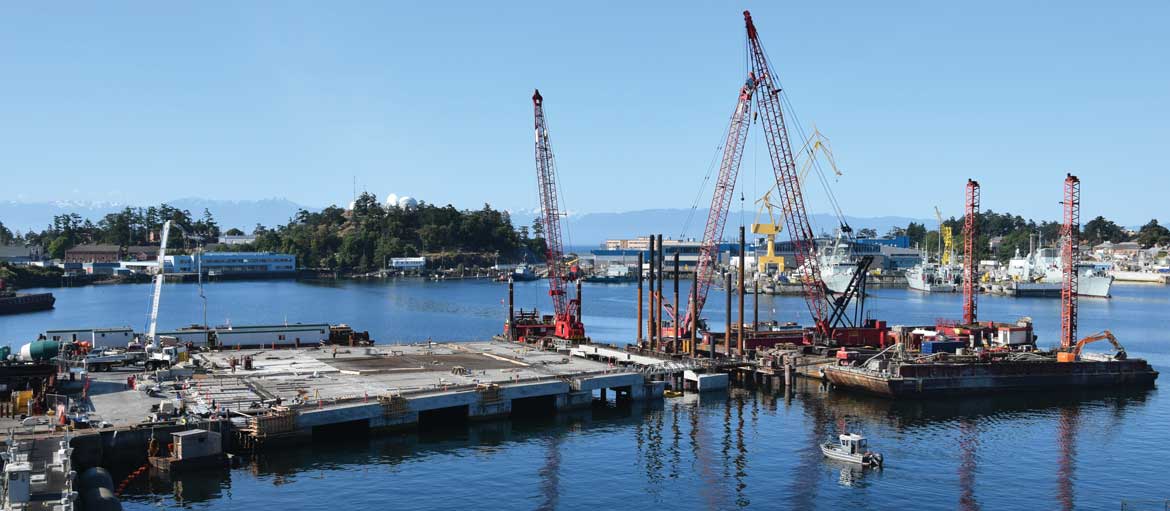
The SPAL/FRPD joint venture qualified as an Aboriginal Business as set out in the federal government’s Procurement Strategy for Aboriginal Business program and was “a natural extension of an ongoing partnership between FRPD and SPAL, who in the past decade have collaborated on 10 joint ventures worth approximately $125 million,” said Mike Bevan-Pritchard, senior vice president, major project development at FRPD.
223 steel pipe piles driven or socketed into bedrock, reinforced and concrete-filled
“This was a very complex and challenging job,” both to design and to build, said Bevan-Pritchard. For the South Jetty, one of the facility’s key berthing platforms, approximately 10,000 square metres of the new steel-and-concrete-pile jetty structure had to be integrated with existing elements, some of which were more than 70 years old.
The facility remained fully operational during construction, and equipment moves had to be coordinated with other ongoing construction projects and various tenants within the active harbour, Bevan-Pritchard says. As there were limited laydown areas onshore, most materials and equipment were stored on floating barges.
“Constructing pile positioning and equipment-support falsework is probably the most important and time-consuming operation.”
Mike Bevan-Pritchard, FRPD
Furthermore, this project was constructed within an active graving dock in a facility owned by the Government of Canada, which meant all contractors and subcontractors working on the project had to have “Reliability Status” under the Government of Canada’s industrial security requirements or be escorted by approved individuals. This reliability clearance became smoother once enough staff and crew had been through the process of organizing and submitting documentation, says Bevan-Pritchard. At the peak period, upwards of 40 to 50 tradesmen, both pile driving and carpentry crews, worked on-site.
The project’s wharf superstructure, deck overlay and pile infill required 600 pieces of precast concrete, including underwater-placed displacement tubes, pile caps, deck panels and 60-tonne fender drops; 800 m3 of lightweight concrete placed in precast duct bank trenches; and 6,100 m3 of cast-in-place concrete, including approximately 50 m3 of underwater concrete that was formed and placed by divers who were subcontracted to do this and other underwater work.
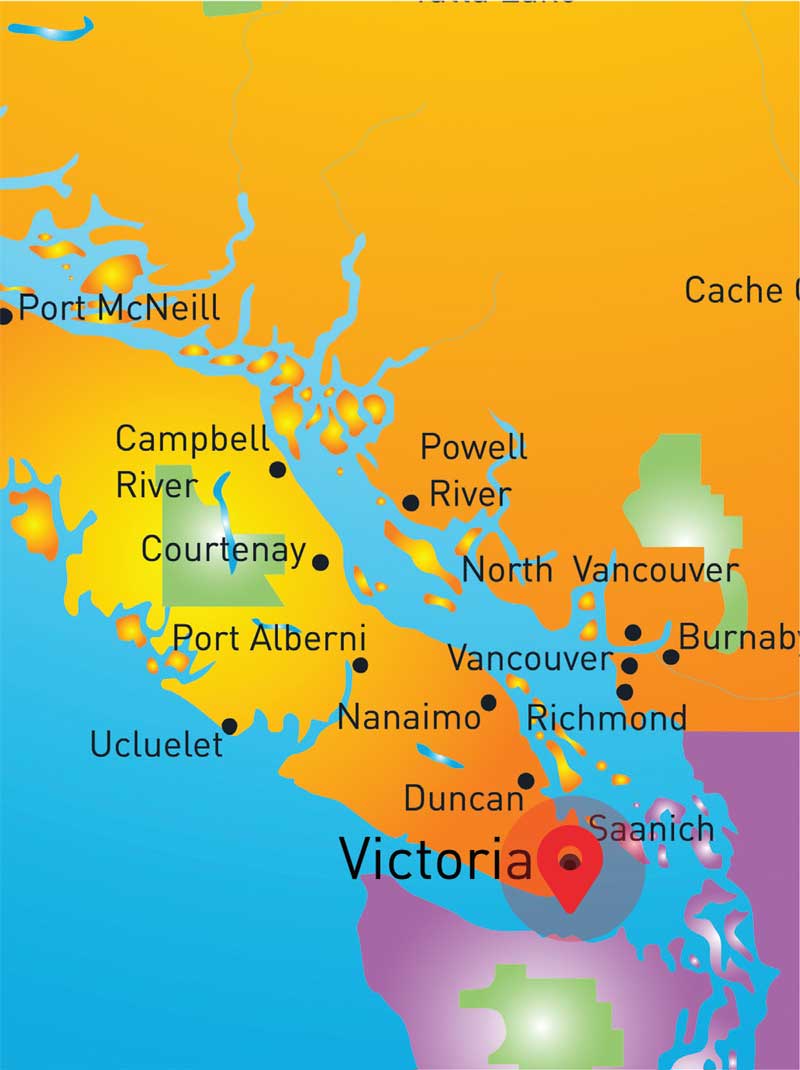
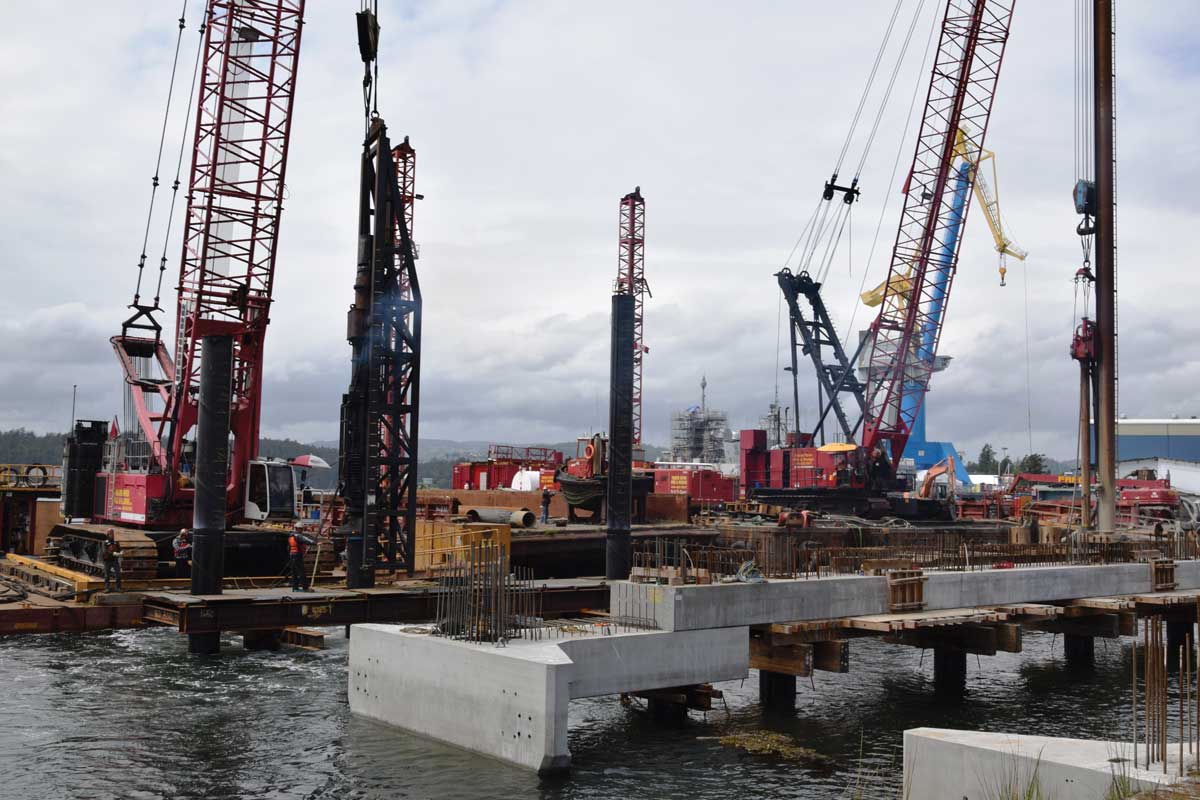
In all, 223 762-mm and 914-mm-diameter pipe piles were driven or socketed into bedrock, reinforced and concrete-filled, and 118 precast concrete piles and fender caps were supplied and placed. In some cases, the overburden reached or even exceeded 55 metres, according to Mike Logan, FRPD senior project manager, and some of the piles themselves were more than 60 metres deep. Most were installed through a minimum 12 to 15 metres of water column.
“Always surprises, especially in Victoria”
The South Jetty reconstruction was spread over three distinct working areas – the east jetty access and the west and south jetties – all requiring the installation of steel pipe piles. Toward the entrance of the dry dock, only a certain number of piles were drilled, says Logan.
“Installing rock-socketed pipe piles really consists of four separate operations,” Bevan-Pritchard said, “each with its own particular challenges: constructing positioning falsework; advancing the pile through the overburden; seating, sealing and drilling the socket; and installing the rebar cage and concrete fill to complete the pile.
“Constructing pile positioning and equipment-support falsework is probably the most important and time-consuming,” he said, but notes that it can be done easily and safely as long as sufficient engineering has been done to ensure the falsework’s capacity to withstand equipment and pile installation loading. “Advancing the pile through overburden is by far the least risky and fastest of the individual operations.
“The specialized churn and reverse-circulation drilling system we used was typical for many of the marine projects we work on.”
Mike Logan, FRPD
“Pipe sections are simply added and weld-spliced in the vertical position until sufficient length is achieved to reach bedrock. The most critical aspect of the drilling operation is ensuring that care is taken to seat the pile in the upper one or two metres of the typically weathered bedrock surface to achieve a watertight seal before drilling the full-length socket.”
The bedrock within Esquimalt Harbour’s South Jetty project proved to be particularly uneven and undulating, and in some areas, it was interwoven with fissure-type cracks, which affected its strength. Once the piles were seated into the bedrock with an under-reaming type drilling bit, rock sockets were drilled to a further 3.2- to 6.8-m depth below the pile tip, Logan says.
“There are always surprises, especially in Victoria,” he said. “Any hill there is either a nice gradual slope or a steep decline, so you never know what you’re going to find.” Due to this large variation, lengthening or shortening of the piles was sometimes required.
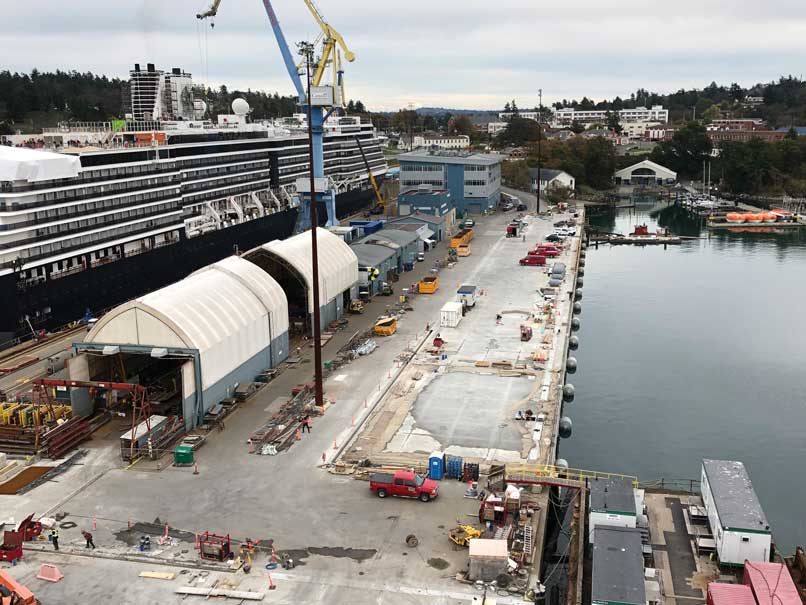
Once the pile and socket were inspected by an underwater camera, prefabricated rebar cages were placed with spacers to the bottom of the pile socket, and the initial concrete pours inside the piles completed by underwater tremie methods.
“In the Victoria area there’s a lot of blue clay, which can be detrimental to drilling systems because it’s very sticky,” said Logan. “The down-the-hole hammer drilling system we used, specialized churn and reverse-circulation drilling, was typical for many of the marine projects we work on.”
Prior to this project, the old timber dock material had been removed and contaminated sediment dredged out and capped by clean riprap and sand. The environmental protection plan stipulated daily, weekly and monthly environmental assessments, and pile installation was able to proceed in a manner that did not adversely impact the previous environmental remediation work, says Bevan-Pritchard. All the material drilled out of the sockets during the drilling process was contained by silt curtains, brought to the surface, put onto specially designed barges and disposed of upland.
Protecting marine life from underwater sound waves using bubble-curtain technology
All the other piles were driven with a vibratory hammer and then driven down to the final depth with an impact hammer, says Logan, with bubble curtains deployed around individual piles during that final process. These “walls” or “curtains” of air bubbles, rising continuously from seabed to surface from closely spaced release points, act as reflectors to scatter sound and reduce the impact of shock and high-amplitude underwater sound pressure on fish and marine mammals.
The power of bubbles to dampen underwater sound was observed more than a century ago, but “I think FRPD was the first to implement the technology on a project about 25 or 30 years ago,” Bevan-Pritchard said, when the company first realized the impact their underwater pile driving in Vancouver Harbour might be having on marine life. “Since then, organizations throughout North America have adopted it as a method of mitigating underwater sound waves.”
“There are always surprises, especially in Victoria. Any hill there is either a nice gradual slope or a steep decline, so you never know what you’re going to find.”
Mike Logan, FRPD
Divers assisted with an underwater cast-in-place pour to connect the precast concrete to the drilled piling. “Divers below water level and our crews above water level – a team effort,” said Logan, also applied a new tidal-wrap pile protection system to the decades-old steel pipe piles that support the existing dock, wrapping them with a coating and then a sleeve of ultrahigh molecular weight polyethylene to extend the pile lifetime by preventing further corrosion and protecting against abrasion.
The tide level is “a daily thing you have to assess on these projects,” affecting planning and scheduling, said Logan, “especially when it involved our final pile cutoffs and the large precast fender panels – typically, you’re in a scenario where you’re installing corbels to support the fenders at very low tide.”
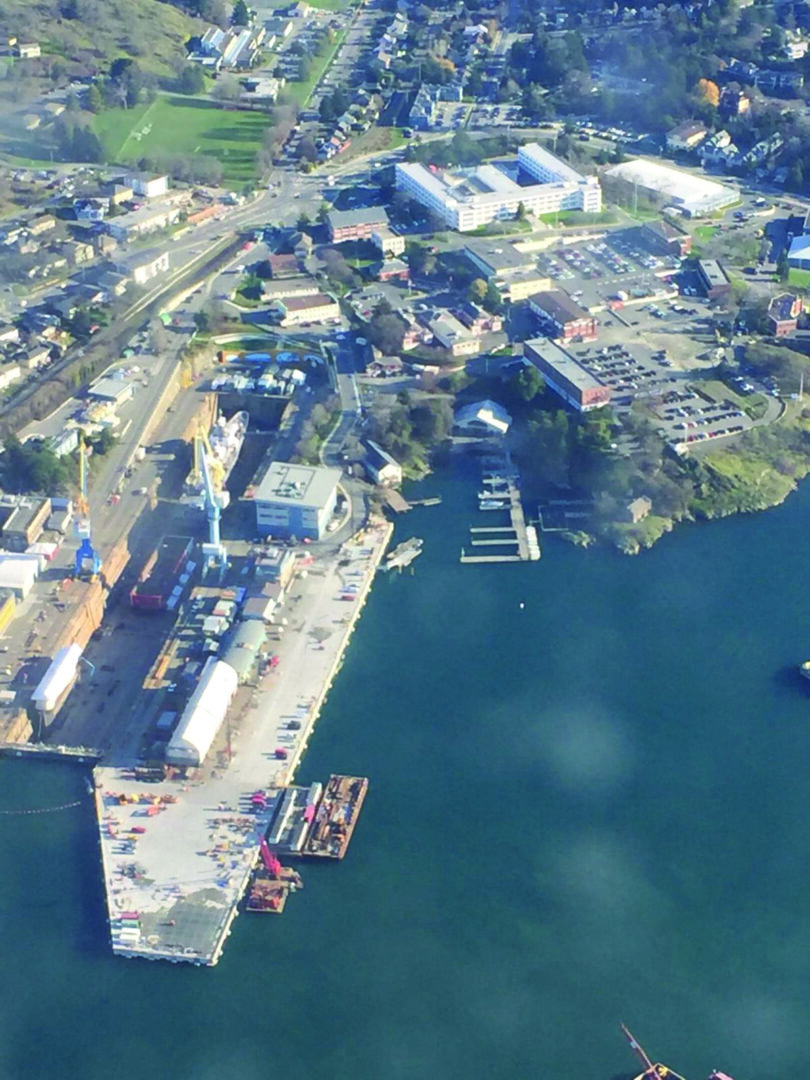
Ocean tide levels can fluctuate four or five metres in Victoria. Low tides occur in the middle of the day in summer, but in winter that’s reversed, Logan says. Since below-water work involving divers is riskier and slower, he said, “A lot of the work we did in the winter was in the middle of the night.” However, the biggest challenge on projects like this is wind that produces wave action or large ocean swells.
“Wind from the west comes directly into the work facility there,” Logan said, adding that losing a few working days because of bad weather conditions is not unusual for a project of this duration. The project, which began in 2018, was substantially completed by spring of 2020, prior to the changes brought on by Covid-19.